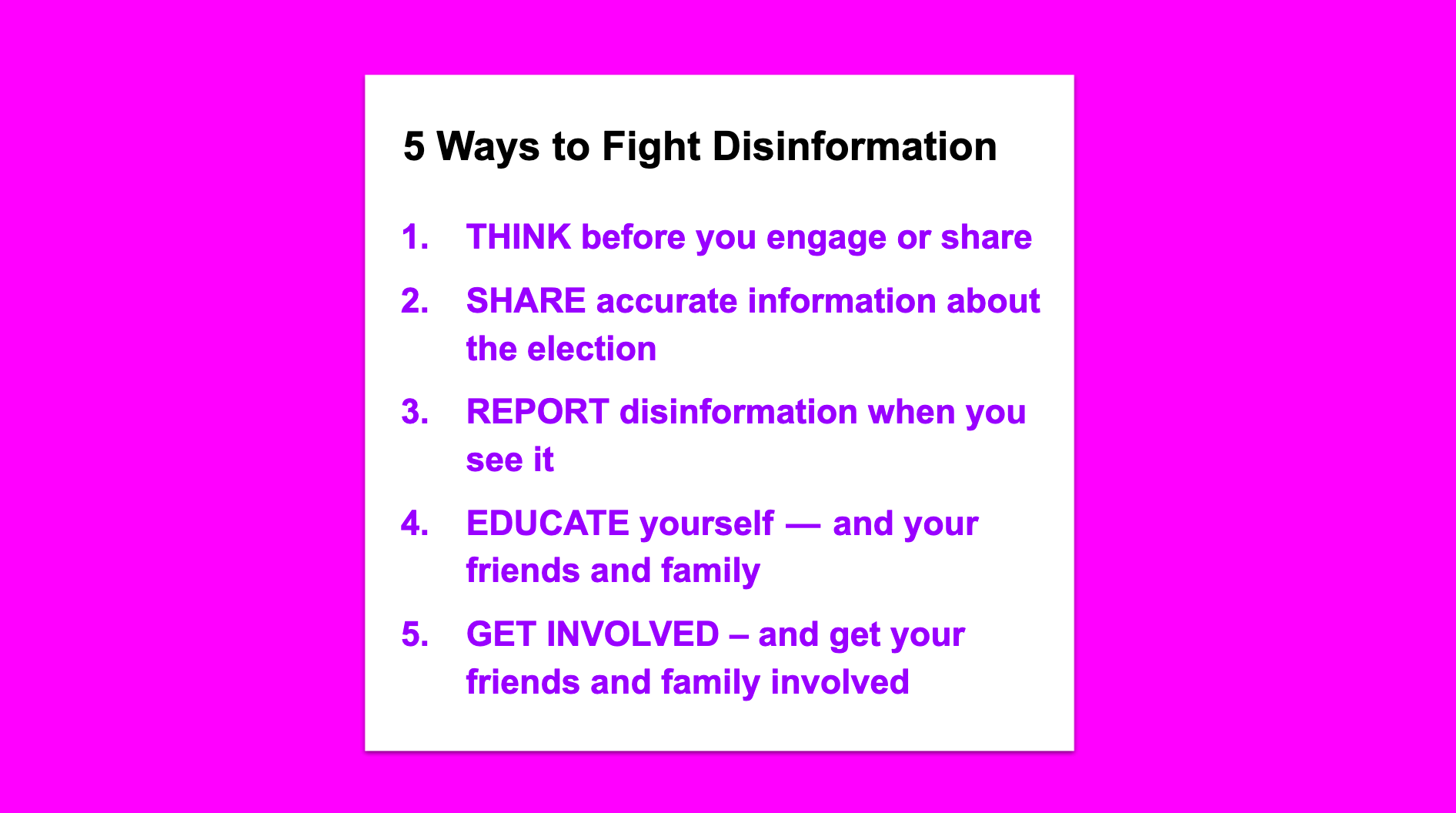5 ways to protect democracy by fighting election disinformation
It's crunch time for democracy in the US. Here's how you can help.
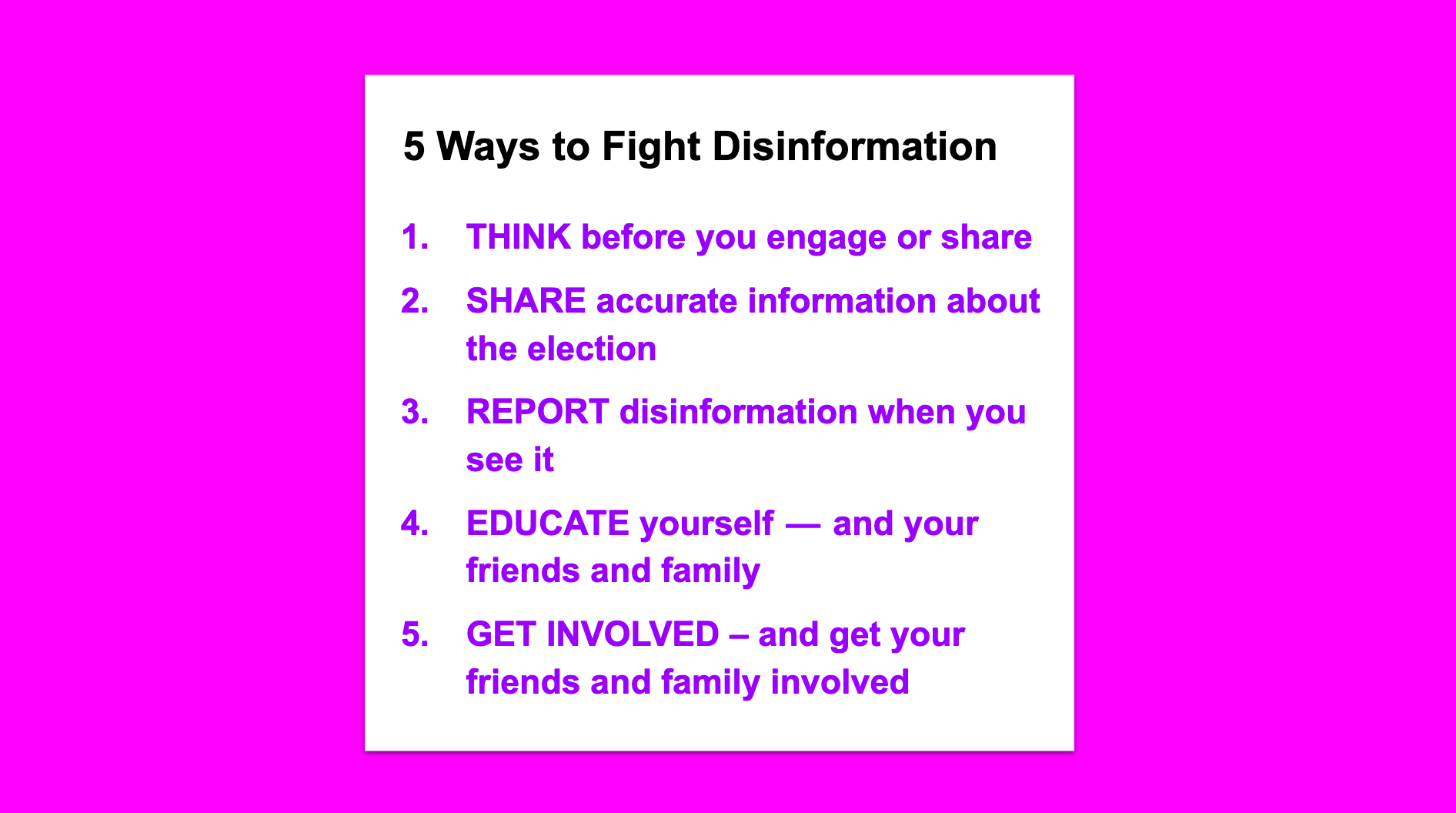
Want to discuss this post? Check out the Nexus of Privacy Dreamwidth community (for now, no login required), and @nexusofprivacy@mastodon.online
In the months leading up to the midterm elections, there have been major efforts to disrupt what is the most basic right in functioning democracies: voting.
– Shireen Mitchell (aka digitalsista) of Stop Online Violence Against Women, in Disinformation: A Racist Tactic, from Slave Revolts to Elections, on Union of Concerned Scientists' The Equation
I write to express my concern about the ongoing spread of disinformation and misinformation through social media platforms operated by your companies. Disinformation and misinformation pose very real and growing threats to our democracy and to the rule of law.
– Calif0rnia Attorney General Bonta, in a letter to the CEOs of Meta, YouTube, Twitter, TikTok, and Reddit
Tuesday is election day in the US – and the manufactured chaos is likely to go on for a while afterwards. After the 2020 election, disinfo fuelled an attempted coup. In 2022, social networks are only taking half-measures to fight disinfo. But wait, there's more.
There's a new racist, transphobic new Chief Twit who's personally boosting homophobic disinfo as well as getting rid of getting rid of half the company – including the head of Trust & Safety, the Human Rights, responsible AI, and accessibility teams. Later this week, Twitter's introducing a new product helping people boost disinfo for only $8/month, such a deal! And then they'll be letting people whose accounts have been suspending for breaking the site's rules against disinfo, hate speech, and harassment back on.
What could possibly go wrong?
Between now and the end of Tuesday, expect lots of digital voter suppression disinfo – like false information about polling place locations and hours. Expect a mix of real and fake reports of voter intimidation and fake announcements of last-minute polling place changes. Once the polls close, the focus will shift to post-election ballot counting, claims of fraud, problems with voting machine, election lawfare ... so many opportunities for disinfo.
Election protection groups and voting rights activists are doing everything they can to fight election info ... but they're outnumbered, and the Chief Twit and his pals have a lot more resources. Grassroots voting rights activism made the difference in 2008 and 2020. It's time to do it again.
Here's how you can help.
- THINK before you engage or share
- SHARE accurate information about the election
- REPORT disinformation when you see it
- EDUCATE yourself — and your friends and family
- GET INVOLVED – and get your friends and family involved
This info is based on work done in 2020 with Shireen, Stop Online Violence Against Women, Indivisible Plus Washington, Indivisible Whidbey, Washington Indivisible Network, and Indivisisble's Truth Brigade. How To Respond to Disinformation and Digital Voter Suppression and Deep Dive goes into more detail (although hasn't been updated for 2022, so some of it's a bit out of date). Thanks to all involved!
1. Think before you engage or share
As Shireen says, if you have an immediate reaction to share a link without verifying or fact-checking, you need to pause and look at things differently. One of the goals of disinformation is to get you to react emotionally. Even if it’s something you agree with, it’s important to think before you engage.
- Is the information you’re about to share accurate and from a reliable source? If not, be very careful not to give it more visibility when you’re trying to debunk it.
- Even if the information you’re about to share is accurate, look at the headline and any images that you’re sharing to make sure they’ve got the right framing.
- Avoid headlines that include disinfo. Instead, look for headlines and articles that focus on the accurate information, or report that there’s disinfo but don’t repeat it.
- If you can’t find a headline and article that work well, consider just quoting a few lines from an article (or taking a screenshot) rather than linking.
- Only share screenshots of disinfo if you are clearly visually labeling them as disinfo.
Shireen’s Deep Dive on Fighting Back Against Disinfo goes into a lot more detail on this. ReFrame also has some great infographics on how to not amplify disinfo, and Union of Concerned Scientists covers this and a lot of other valuable topics in Countering Disinformation in Your Community.
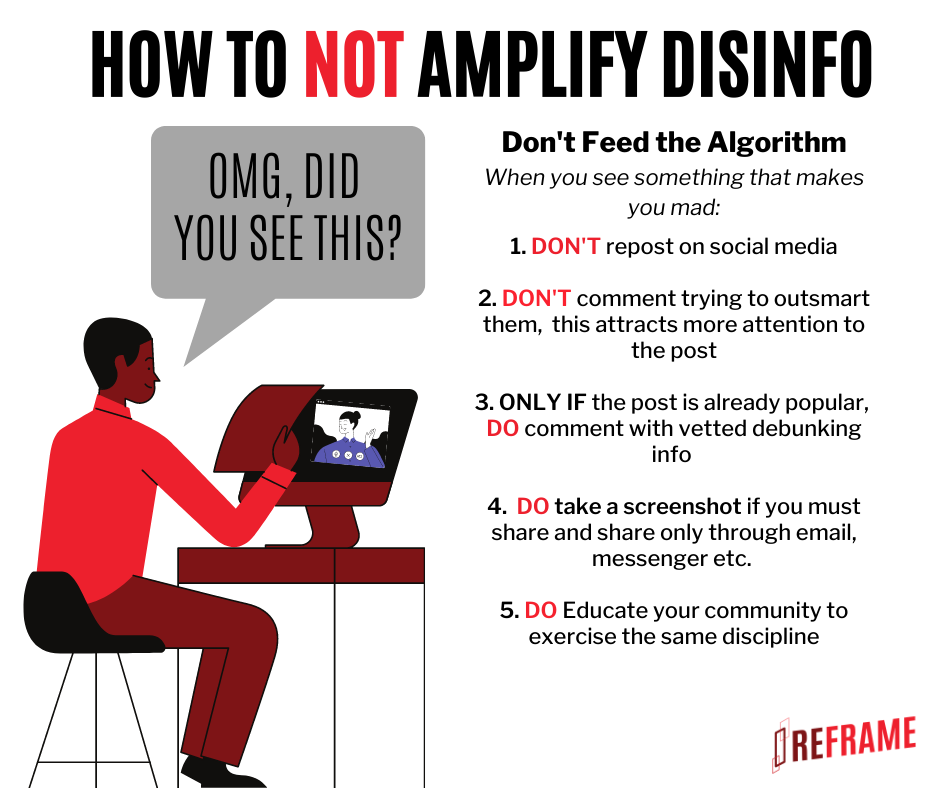
Image description: somebody typing the words "OMG DID YOU SEE THIS". Text: How to not amplify disinfo. Don't feed the algorithm. When you see something that makes you mad: 1. DON’T repost on social media 2. DON’T comment trying to outsmart them, this attracts more attention to the post 3. ONLY IF the post is already popular, DO comment with vetted debugging info. 4. DO take a screenshot if you must share, and share only through email, messenger, etc. 5. DO educate your community to exercise the same discipline. Reframe.
Thinking carefully about how to engage is important because the algorithms that drive social networks like Facebook and Twitter give more attention to content that’s engaging people. So whenever you get share a link (even if you’re saying “OMG look at this fake information!”) or involved in a discussion in the comments debunking or debating a post that’s disinformation, you’re calling more attention to it.
When you do decide to engage with disinformation, here’s the approach that ReFrame and other disinfo experts suggest this four-step process.
- Lead with shared values to connect with your audience.
- Discredit the falsehood by naming the motivations driving the
disinformation. - State the falsehood you intend to inoculate against.
- Deliver factual information to combat the falsehood.
2. Share accurate information about the election
What is your plan to promote accurate, aspirational and actionable information about the solutions needed to protect your/our freedoms regarding the 2022 midterm election?
– – Shireen Mitchell in Disinformation: A Racist Tactic, from Slave Revolts to Elections
The last few days of voting are always somewhat chaotic: with ballot box and polling place closures, long lines and broken machines, and reports of voter intimidation. One common (and illegal) digital voter suppression tactic is to share wrong addresses or inaccurate hours for polling places via texts and s social media. This year, it's bad enough that Texas and Ohio election officials have already issued alerts, and incidents have been reported in states across the country.
One good way to counter disinformation about the election process is to share accurate information about the election. Take the time to verify that the information you’re sharing is accurate before you share updates! Things will get especially murky on Twitter once the new features allowing anybody to buy a verification checkmark for $8 get rolled out on Tuesday.
Voting rights organizations, official state and county election sites, and reputable local media are usually the most reliable sources. I Will Vote makes it easy to find your voting or drop-off information, for example, and Common Cause lets you find your polling place or find your local election office. Share these links widely!
On Twitter, lists like Election Protection coalition's national and state partners are good starting points. So is The Leadership Conference's coalition list, and the League of Women Voters' Vote411. You can check all of these even if you don't have a Twitter account.
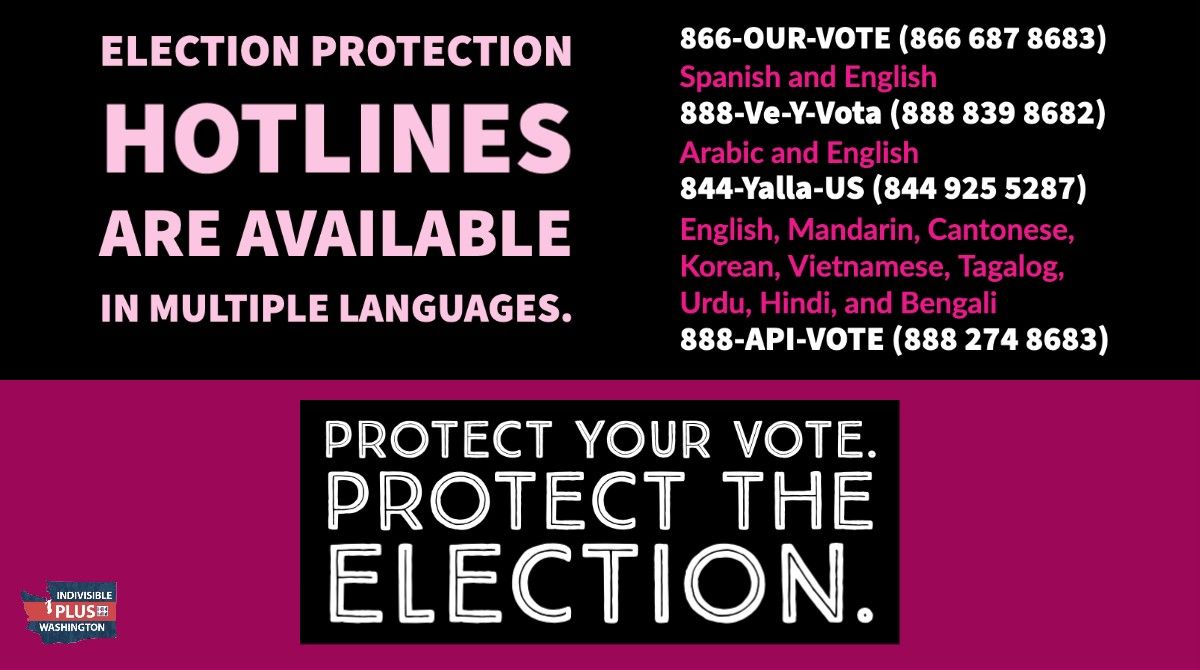
It’s also good to highlight the non-partisan Election Protection hotlines, useful for anybody experience voter intimidation or having other challenges voting. Trained volunteers are available in multiple languages:
English: 866-OUR-VOTE (866 687 8683)
Spanish/English: 888-Ve-Y-Vota (888 839 8682)
Arabic/English: 844-Yalla-US (844 925 5287)
English, Mandarin, Cantonese, Korean, Vietnamese, Tagalog, Urdu, Hindi, and Bengali: 888-API-VOTE (888 274 8683)
You can also contact Election Protection via WhatsApp, chat with them on their site 866ourvote.org or text MYVOTE to 866–687–8683.
3. Report disinformation when you see it
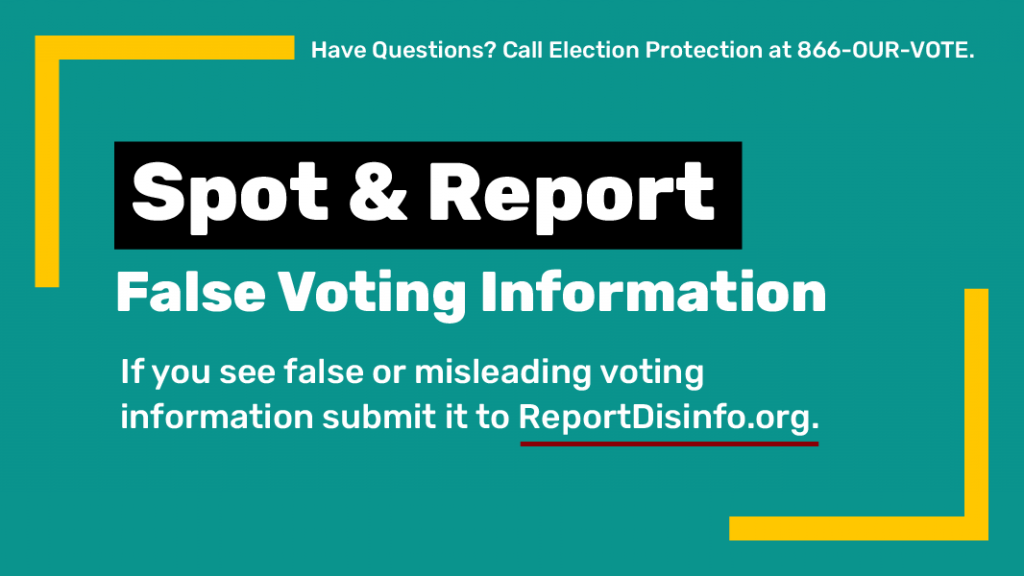
ReportDisinfo.org is an easy-to-use site to report disinformation, run by Common Cause Election Fund. You can include a link to the web page, or upload an image.
Social network sites all provide ways to report disinformation. The World Health Organization has a page with links for how to report on Facebook, Twitter, YouTube, WhatsApp, TikTok and other sites. The more people who report a post, the more likely it is that companies will fact-check it and potentially take it down. There's no guarantee – it's incredibly frustrating, but social network platforms will often let blatant disinformation go even after it's been reported – but it's still worth doing.
4. Educate yourselves — and your friends and family — about disinformation
You're not the only person who needs to recognize disinformation, avoid amplifying it, and respond. Your friends, family, and colleagues do as well. So as well as educating yourself, please share the knowledge.
A lot of great resources produced for the 2020 election about how to respond to disinfo are still incredibly relevant. This short video from PEN America, and the videos in the previous sections, are all great two-minute introductions to what you can do about disinformation. Union of Concerned Scientists' Countering Disinformation in Your Community and PEN America's How to Talk to Friends and Family Who Share Misinformation are also excellent resources. Check them out out – and share this information widely.
5. Get involved – and get your friends involved!
Getting out accurate voting and election protection information, or reporting disinfo when you see it, may seem mundane ... but if enough people are involved, it can make a big difference. The more people who reduce the amount of disinfo they're unentionally amplifying the better. A lot of people still don't know how to deal with disinfo, so helping educate friends and family has a huge impact as well.
If you want to do more, consider joining a grassroots disinfo fighting campaign. Two good non-partisan options: Common Cause's social media monitoring team and Indivisible's Truth Brigade. And some candidates, or state and local party organizations, also have disinfo-fighting teams (or be interested in starting one if they don't exist yet – remember, the election doesn't end when the polls close), so check with the ones you support.
It's crunch time for democracy in the United States, so if that's something you care about, now's a good time to get involved.
